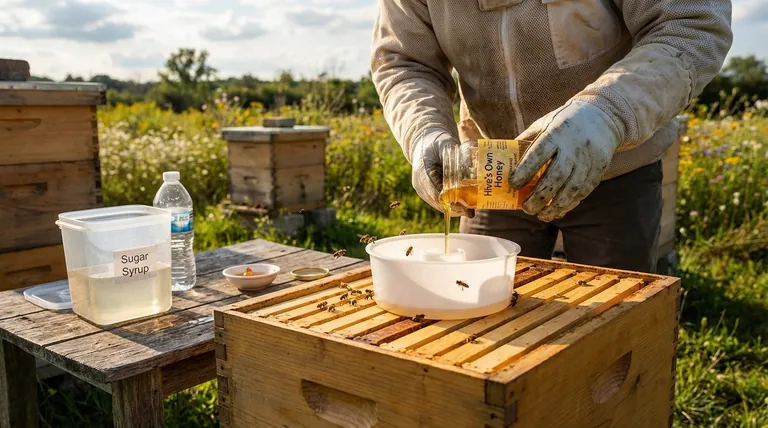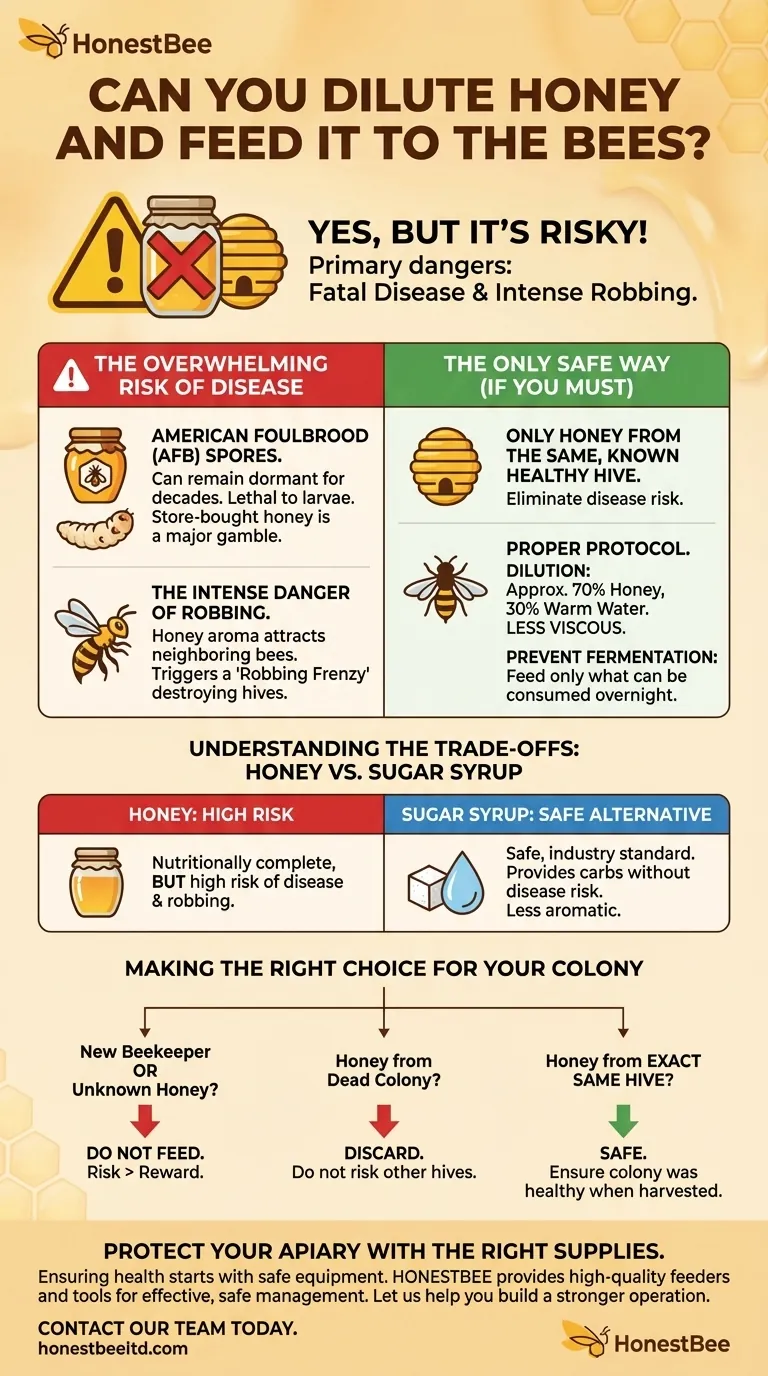Yes, you can feed diluted honey to bees, but this practice comes with significant and potentially devastating risks. The primary dangers are introducing fatal diseases to your hive and triggering intense robbing behavior from other colonies. For these reasons, it is only considered safe under very specific conditions.
The central takeaway is this: Never feed your bees honey from an unknown source, especially store-bought honey. The only honey that is safe to feed back to a colony is clean honey that you harvested from that exact same hive, as this eliminates the risk of introducing foreign diseases.

The Core Principle: Why Honey is a Double-Edged Sword
Honey is the perfect food for bees, but feeding it back to them in a liquid form fundamentally changes the risk profile compared to when they are consuming it directly from their own comb.
The Overwhelming Risk of Disease
The most critical danger in feeding honey is the transmission of disease, particularly American Foulbrood (AFB).
AFB spores can remain dormant in honey for decades. While completely harmless to humans, these spores are lethal to bee larvae and can destroy an entire colony.
Store-bought honey often comes from a blend of sources, some of which may have been infected. Feeding this honey to your bees is a gamble that can introduce a catastrophic and highly contagious disease into your apiary.
The Intense Danger of Robbing
Honey has a much stronger and more attractive aroma to bees than plain sugar syrup.
Placing a feeder of diluted honey, especially in an external feeder, can quickly attract bees from neighboring hives. This can incite a "robbing frenzy," where stronger colonies attack and overwhelm your hive to steal its resources, often killing the queen and many workers in the process.
Even small spills near the hive can be enough to trigger this destructive behavior.
The Correct Way to Feed Honey (If You Must)
If you are certain the honey came from a strong, disease-free hive and you intend to feed it back to that same hive, there is a protocol to follow. This is most common when using crystallized honey from a previous harvest from that colony.
The Proper Dilution Ratio
A common mixture is approximately 70% honey to 30% warm water. The goal is to make the honey less viscous and easier for the bees to take down and process quickly.
Preventing Fermentation
Only provide an amount of diluted honey that the bees can consume in a short period, ideally overnight.
If you provide too much, the mixture can sit in the feeder, ferment, and become unsuitable or even harmful for the bees.
Understanding the Trade-offs: Honey vs. Sugar Syrup
For beekeepers, the choice between feeding honey and sugar syrup is a decision between a natural food source with high risks and a safe, standard alternative.
Honey: High Risk, Situational Reward
Honey is a nutritionally complete food for bees. However, the risks of disease and robbing are so high that feeding liquid honey is a practice best avoided by all but the most experienced beekeepers in very specific situations.
Sugar Syrup: The Safe, Standard Alternative
A simple syrup made from white cane sugar and water (typically a 1:1 ratio for stimulation or 2:1 for winter stores) is the industry standard for feeding bees.
It provides the necessary carbohydrates without the risk of transmitting bee-specific pathogens. It is also less aromatic, reducing (but not eliminating) the risk of robbing.
Making the Right Choice for Your Colony
Your decision should always prioritize the long-term health and safety of your bees over the convenience of using available honey.
- If you are a new beekeeper or the honey's origin is unknown: Do not feed the honey. The risk of wiping out your colony with an imported disease is far too great.
- If you have honey from a dead colony: Discard it. You cannot be 100% certain that disease was not the cause of the colony's failure, and feeding that honey puts your other hives at extreme risk.
- If you are using honey from the exact same hive: This is the only safe scenario. Ensure the colony was healthy when the honey was harvested and only feed it back to that original colony.
Ultimately, protecting your colony from preventable disease is the most important responsibility of any beekeeper.
Summary Table:
| Feeding Option | Primary Risk | Safe Use Condition |
|---|---|---|
| Diluted Honey | Disease Transmission (e.g., American Foulbrood) & Robbing | Only from the same, known healthy hive |
| Sugar Syrup | Minimal (fermentation if overfed) | Standard practice; safe for all hives |
Protect Your Apiary with the Right Supplies
Ensuring the health of your bees starts with using safe, reliable equipment and practices. As a trusted supplier for commercial apiaries and beekeeping equipment distributors, HONESTBEE provides the high-quality feeders and tools you need to manage your colonies effectively and safely.
Let us help you build a stronger, healthier operation. Contact our team today to discuss your wholesale needs and discover how our beekeeping supplies can support your success.
Visual Guide

Related Products
- Rapid Bee Feeder White Plastic 2L Round Top Feeder for 8 or 10-Frame Bee Hives
- HONESTBEE Advanced Ergonomic Stainless Steel Hive Tool for Beekeeping
- Professional Dual-End Stainless Steel Hive Tool for Beekeeping
- Professional 3-Bar Frame Grip with Integrated Hive Tool
- Yellow Plastic Bucket Pail Perch for Beekeeping
People Also Ask
- Can sugar syrup contaminate the honey crop? A Beekeeper's Guide to Protecting Honey Purity
- How much honey does a strong hive need to survive winter? Ensure Your Colony's Survival (60-80 lbs)
- Do beekeepers leave honey for bees? The Essential Guide to Sustainable Hive Management
- What is the capacity of the round hive top feeder for syrup and pollen? A Guide to Targeted Apiary Support
- How do you set up and use a top feeder for bees? A Step-by-Step Guide for Safe Feeding



















